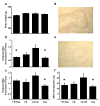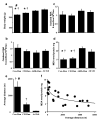Comparison of lifelong and late life exercise on oxidative stress in the cerebellum
- PMID: 17976863
- PMCID: PMC2695411
- DOI: 10.1016/j.neurobiolaging.2007.09.005
Comparison of lifelong and late life exercise on oxidative stress in the cerebellum
Abstract
Aging was associated with increased oxidation of DNA, RNA, and lipids in the cerebellum of male rats. DNA and lipid oxidation was reduced by lifelong (94 weeks) voluntary exercise on a running wheel. A reduction in cerebellar lipid oxidation, but not RNA or DNA oxidation, was observed following 3 months of moderate exercise or dietary supplementation of vitamin E, initiated at 18 months of age. The level of lipid oxidation correlated with measures of forelimb grip strength. The results indicate that lifelong exercise attenuates multiple molecular markers of age-related oxidative damage in the cerebellum. In addition, modest exercise initiated late in life can have a beneficial effect on lipid oxidation and motor function.
Figures



References
-
- Andersen BB, Gundersen HJ, Pakkenberg B. Aging of the human cerebellum: a stereological study. J Comp Neurol. 2003;466(3):356–65. - PubMed
-
- Barja G. Free radicals and aging. Trends Neurosci. 2004;27(10):595–600. - PubMed
-
- Cardozo-Pelaez F, Song S, Parthasarathy A, Hazzi C, Naidu K, Sanchez-Ramos J. Oxidative DNA damage in the aging mouse brain. Mov Disord. 1999;14(6):972–80. - PubMed
-
- Carter CS, Cesari M, Ambrosius WT, Hu N, Diz D, Oden S, Sonntag WE, Pahor M. Angiotensin-converting enzyme inhibition, body composition, and physical performance in aged rats. J Gerontol A Biol Sci Med Sci. 2004;59(5):416–23. - PubMed
Publication types
MeSH terms
Substances
Grants and funding
LinkOut - more resources
Full Text Sources
Medical

